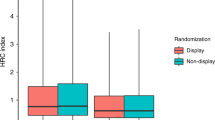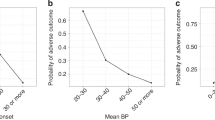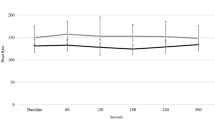Abstract
Background
Monitoring of heart rate characteristics (HRC) index may improve outcomes of late-onset neonatal sepsis (LOS) through early detection. We aimed at describing the association between LOS and elevated HRC index.
Methods
This single-center retrospective case–control study included neonates who presented with blood culture-proven hospital-acquired LOS. Controls were matched to cases (ratio 1:2) based on gestational age, postnatal age, and birthweight. We compared the highest HRC indexes in the 48 h preceding blood culture sampling in LOS cases to the highest HRC indexes at the same postnatal days in controls.
Results
In 59 LOS cases and 123 controls, an HRC index > 2 was associated with LOS (OR 7.1, 95% CI 2.6–19.0). Sensitivity and specificity of an HRC index > 2 to predict LOS were 53% (32/59) and 79% (98/123). Sensitivity increased from 25% in infants born > 32 weeks to 76% in infants born < 28 weeks. Specificity decreased from 97% in infants > 32 weeks to 63% in those born < 28 weeks.
Conclusions
An increase of HRC index > 2 has a significant association with the diagnosis of LOS, supporting the use of HRC monitoring to assist early detection of LOS. Clinicians using HRC monitoring should be aware of its diagnostic accuracy and limitations in different gestational age groups.
Impact
-
There is a paucity of data regarding the predictive value of heart rate characteristics (HRC) monitoring for early diagnosis of late-onset neonatal sepsis (LOS) in daily clinical practice.
-
Monitoring of heart rate characteristics provides valuable information to assist the early diagnosis of LOS across all gestational age groups.
-
However, the strong influence of gestational age on positive and negative predictive values adds complexity to the interpretation of HRC indexes.
Similar content being viewed by others
Log in or create a free account to read this content
Gain free access to this article, as well as selected content from this journal and more on nature.com
or
References
Shane, A. L., Sanchez, P. J. & Stoll, B. J. Neonatal sepsis. Lancet 390, 1770–1780 (2017).
Stoll, B. J. et al. Late-onset sepsis in very low birth weight neonates: the experience of the NICHD neonatal research network. Pediatrics 110, 285–291 (2002).
Stoll, B. J. et al. Neonatal outcomes of extremely preterm infants from the NICHD neonatal research network. Pediatrics 126, 443–456 (2010).
Giannoni, E. et al. Neonatal sepsis of early onset, and hospital-acquired and community-acquired late onset: a prospective population-based cohort study. J. Pediatr. 201, 106–114.e104 (2018).
Giannoni, E. & Schlapbach, L. J. Editorial: sepsis in neonates and children. Front. Pediatr. 8, 621663 (2020).
Griffin, M. P. et al. Abnormal heart rate characteristics preceding neonatal sepsis and sepsis-like illness. Pediatr. Res. 53, 920–926 (2003).
Griffin, M. P. et al. Abnormal heart rate characteristics are associated with neonatal mortality. Pediatr. Res. 55, 782–788 (2004).
Moorman, J. R. et al. Mortality reduction by heart rate characteristic monitoring in very low birth weight neonates: a randomized trial. J. Pediatr. 159, 900–906 e901 (2011).
Groves, A. M. & Edwards, A. D. Heart rate characteristic monitoring-hero or villain? J. Pediatr. 159, 885–886 (2011).
Stone, M. L. et al. Abnormal heart rate characteristics before clinical diagnosis of necrotizing enterocolitis. J. Perinatol. 33, 847–850 (2013).
Sullivan, B. A. et al. Early heart rate characteristics predict death and morbidities in preterm infants. J. Pediatr. 174, 57–62 (2016).
Weitkamp, J. H. The role of biomarkers in suspected neonatal sepsis. Clin. Infect. Dis. 73, e391–e393 (2021).
Coggins, S. A. et al. Heart rate characteristic index monitoring for bloodstream infection in an NICU: a 3-year experience. Arch. Dis. Child Fetal Neonatal Ed. 101, F329–F332 (2016).
Sullivan, B. A., Grice, S. M., Lake, D. E., Moorman, J. R. & Fairchild, K. D. Infection and other clinical correlates of abnormal heart rate characteristics in preterm infants. J. Pediatr. 164, 775–780 (2014).
Kumar, A. et al. Duration of hypotension before initiation of effective antimicrobial therapy is the critical determinant of survival in human septic shock. Crit. Care Med. 34, 1589–1596 (2006).
Weiss, S. L. et al. Delayed antimicrobial therapy increases mortality and organ dysfunction duration in pediatric sepsis. Crit. Care Med. 42, 2409–2417 (2014).
Schmatz, M. et al. Surviving sepsis in a referral neonatal intensive care unit: association between time to antibiotic administration and in-hospital outcomes. J. Pediatr. 217, 59–65.e51 (2020).
Swanson, J. R. et al. Neonatal intensive care unit length of stay reduction by heart rate characteristics monitoring. J. Pediatr. 198, 162–167 (2018).
Zimmet, A. M., Sullivan, B. A., Moorman, J. R., Lake, D. E. & Ratcliffe, S. J. Trajectories of the heart rate characteristics index, a physiomarker of sepsis in premature infants, predict neonatal icu mortality. JRSM Cardiovasc. Dis. 9, 2048004020945142 (2020).
Fairchild, K. D. et al. Vital signs and their cross-correlation in sepsis and nec: a study of 1,065 very-low-birth-weight infants in two nicus. Pediatr. Res 81, 315–321 (2017).
Masino, A. J. et al. Machine learning models for early sepsis recognition in the neonatal intensive care unit using readily available electronic health record data. PLoS ONE 14, e0212665 (2019).
Mani, S. et al. Medical decision support using machine learning for early detection of late-onset neonatal sepsis. J. Am. Med. Inf. Assoc. 21, 326–336 (2014).
Zeigler, A. C., Ainsworth, J. E., Fairchild, K. D., Wynn, J. L. & Sullivan, B. A. Sepsis and mortality prediction in very low birth weight infants: analysis of HeRO and nSOFA. Am. J. Perinatol. https://doi.org/10.1055/s-0041-1728829 (2021). Online ahead of print.
Chiera, M. et al. Heart rate variability in the perinatal period: a critical and conceptual review. Front. Neurosci. 14, 561186 (2020).
Acknowledgements
Eric Giannoni is supported by the Leenaards Foundation.
Author information
Authors and Affiliations
Contributions
L.R.: Conception or design of the work; data acquisition; data analysis and interpretation; drafting the article; critical revision of the article and final approval of the version to be published. A.-S.R.: Conception or design of the work; data analysis and interpretation; drafting the article; critical revision of the article and final approval of the version to be published. P.B.: Data analysis and interpretation; drafting the article; critical revision of the article and final approval of the version to be published. C.S.: Data acquisition; drafting the article and final approval of the version to be published. S.A.: Conception or design of the work; data analysis and interpretation; drafting the article; critical revision of the article and final approval of the version to be published. E.G.: Conception or design of the work; data acquisition; data analysis and interpretation; drafting the article; critical revision of the article and final approval of the version to be published.
Corresponding author
Ethics declarations
Consent statement
Patient consent was not required for this study.
Competing interests
The authors declare no competing interests.
Additional information
Publisher’s note Springer Nature remains neutral with regard to jurisdictional claims in published maps and institutional affiliations.
Supplementary information
Rights and permissions
About this article
Cite this article
Rio, L., Ramelet, AS., Ballabeni, P. et al. Monitoring of heart rate characteristics to detect neonatal sepsis. Pediatr Res 92, 1070–1074 (2022). https://doi.org/10.1038/s41390-021-01913-9
Received:
Revised:
Accepted:
Published:
Issue date:
DOI: https://doi.org/10.1038/s41390-021-01913-9
This article is cited by
-
Neonatal leucocyte cell population data: reference intervals and relevance for detecting sepsis and necrotizing enterocolitis
Pediatric Research (2025)
-
Expert review of CLABSI prevention in the NICU: supporting the transition of investigational drugs into clinical practice
European Journal of Pediatrics (2025)
-
Fetal heart rate variability is a biomarker of rapid but not progressive exacerbation of inflammation in preterm fetal sheep
Scientific Reports (2022)



